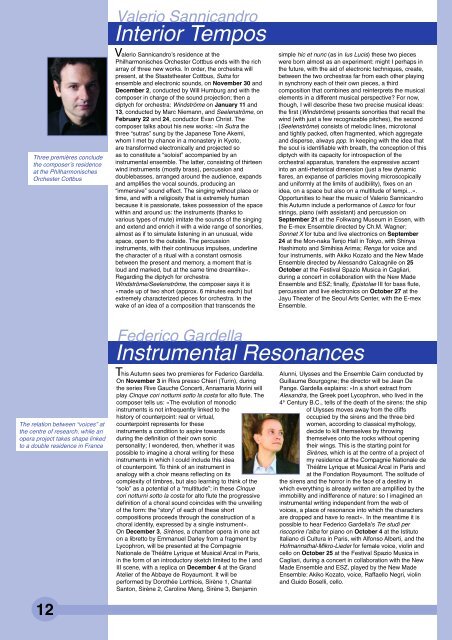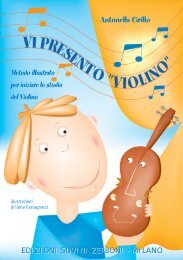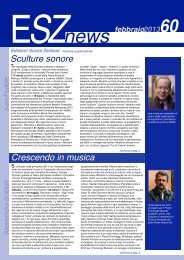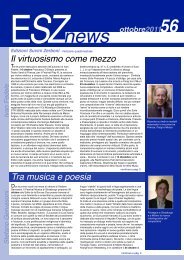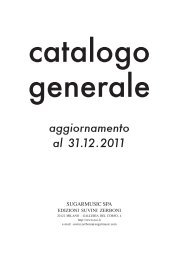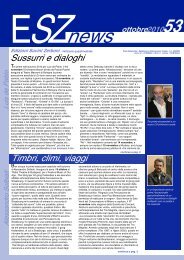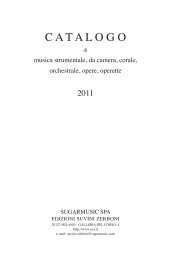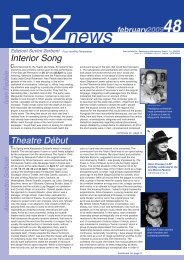Timbral Spaces Sound Labyrinths - Edizioni Suvini Zerboni
Timbral Spaces Sound Labyrinths - Edizioni Suvini Zerboni
Timbral Spaces Sound Labyrinths - Edizioni Suvini Zerboni
You also want an ePaper? Increase the reach of your titles
YUMPU automatically turns print PDFs into web optimized ePapers that Google loves.
Three premières conclude<br />
the composer’s residence<br />
at the Philharmonisches<br />
Orchester Cottbus<br />
The relation between “voices” at<br />
the centre of research, while an<br />
opera project takes shape linked<br />
to a double residence in France<br />
12<br />
Valerio Sannicandro<br />
Interior Tempos<br />
V<br />
alerio Sannicandro’s residence at the<br />
Philharmonisches Orchester Cottbus ends with the rich<br />
array of three new works. In order, the orchestra will<br />
present, at the Staatstheater Cottbus, Sutra for<br />
ensemble and electronic sounds, on November 30 and<br />
December 2, conducted by Will Humburg and with the<br />
composer in charge of the sound projection; then a<br />
diptych for orchestra: Windströme on January 11 and<br />
13, conducted by Marc Niemann, and Seelenströme, on<br />
February 22 and 24, conductor Evan Christ. The<br />
composer talks about his new works: «In Sutra the<br />
three “sutras” sung by the Japanese Tone Akemi,<br />
whom I met by chance in a monastery in Kyoto,<br />
are transformed electronically and projected so<br />
as to constitute a “soloist” accompanied by an<br />
instrumental ensemble. The latter, consisting of thirteen<br />
wind instruments (mostly brass), percussion and<br />
doublebasses, arranged around the audience, expands<br />
and amplifies the vocal sounds, producing an<br />
“immersive” sound effect. The singing without place or<br />
time, and with a religiosity that is extremely human<br />
because it is passionate, takes possession of the space<br />
within and around us: the instruments (thanks to<br />
various types of mute) imitate the sounds of the singing<br />
and extend and enrich it with a wide range of sonorities,<br />
almost as if to simulate listening in an unusual, wide<br />
space, open to the outside. The percussion<br />
instruments, with their continuous impulses, underline<br />
the character of a ritual with a constant osmosis<br />
between the present and memory, a moment that is<br />
loud and marked, but at the same time dreamlike».<br />
Regarding the diptych for orchestra<br />
Windströme/Seelenströme, the composer says it is<br />
«made up of two short (approx. 6 minutes each) but<br />
extremely characterized pieces for orchestra. In the<br />
wake of an idea of a composition that transcends the<br />
Federico Gardella<br />
simple hic et nunc (as in Ius Lucis) these two pieces<br />
were born almost as an experiment: might I perhaps in<br />
the future, with the aid of electronic techniques, create,<br />
between the two orchestras far from each other playing<br />
in synchrony each of their own pieces, a third<br />
composition that combines and reinterprets the musical<br />
elements in a different musical perspective? For now,<br />
though, I will describe these two precise musical ideas:<br />
the first (Windströme) presents sonorities that recall the<br />
wind (with just a few recognizable pitches), the second<br />
(Seelenströme) consists of melodic lines, microtonal<br />
and tightly packed, often fragmented, which aggregate<br />
and disperse, always ppp. In keeping with the idea that<br />
the soul is identifiable with breath, the conception of this<br />
diptych with its capacity for introspection of the<br />
orchestral apparatus, transfers the expressive accent<br />
into an anti-rhetorical dimension (just a few dynamic<br />
flares, an expanse of particles moving microscopically<br />
and uniformly at the limits of audibility), fixes on an<br />
idea, on a space but also on a multitude of tempi...».<br />
Opportunities to hear the music of Valerio Sannicandro<br />
this Autumn include a performance of Lasco for four<br />
strings, piano (with assistant) and percussion on<br />
September 21 at the Folkwang Museum in Essen, with<br />
the E-mex Ensemble directed by Ch.M. Wagner;<br />
Sonnet X for tuba and live electronics on September<br />
24 at the Mon-naka Tenjo Hall in Tokyo, with Shinya<br />
Hashimoto and Simihisa Arima; Renga for voice and<br />
four instruments, with Akiko Kozato and the New Made<br />
Ensemble directed by Alessandro Calcagnile on 25<br />
October at the Festival Spazio Musica in Cagliari,<br />
during a concert in collaboration with the New Made<br />
Ensemble and ESZ; finally, Epistolae III for bass flute,<br />
percussion and live electronics on October 27 at the<br />
Jayu Theater of the Seoul Arts Center, with the E-mex<br />
Ensemble.<br />
Instrumental Resonances<br />
T<br />
his Autumn sees two premieres for Federico Gardella.<br />
On November 3 in Riva presso Chieri (Turin), during<br />
the series Rive Gauche Concerti, Annamaria Morini will<br />
play Cinque cori notturni sotto la costa for alto flute. The<br />
composer tells us: «The evolution of monodic<br />
instruments is not infrequently linked to the<br />
history of counterpoint: real or virtual,<br />
counterpoint represents for these<br />
instruments a condition to aspire towards<br />
during the definition of their own sonic<br />
personality; I wondered, then, whether it was<br />
possible to imagine a choral writing for these<br />
instruments in which I could include this idea<br />
of counterpoint. To think of an instrument in<br />
analogy with a choir means reflecting on its<br />
complexity of timbres, but also learning to think of the<br />
“solo” as a potential of a “multitude”; in these Cinque<br />
cori notturni sotto la costa for alto flute the progressive<br />
definition of a choral sound coincides with the unveiling<br />
of the form: the “story” of each of these short<br />
compositions proceeds through the construction of a<br />
choral identity, expressed by a single instrument».<br />
On December 3, Sirènes, a chamber opera in one act<br />
on a libretto by Emmanuel Darley from a fragment by<br />
Lycophron, will be presented at the Compagnie<br />
Nationale de Théâtre Lyrique et Musical Arcal in Paris,<br />
in the form of an introductory sketch limited to the I and<br />
III scene, with a replica on December 4 at the Grand<br />
Atelier of the Abbaye de Royaumont. It will be<br />
performed by Dorothée Lorthiois, Sirène 1, Chantal<br />
Santon, Sirène 2, Caroline Meng, Sirène 3, Benjamin<br />
Alunni, Ulysses and the Ensemble Cairn conducted by<br />
Guillaume Bourgogne; the director will be Jean De<br />
Pange. Gardella explains: «In a short extract from<br />
Alexandra, the Greek poet Lycophron, who lived in the<br />
4 th Century B.C., tells of the death of the sirens: the ship<br />
of Ulysses moves away from the cliffs<br />
occupied by the sirens and the three bird<br />
women, according to classical mythology,<br />
decide to kill themselves by throwing<br />
themselves onto the rocks without opening<br />
their wings. This is the starting point for<br />
Sirènes, which is at the centre of a project of<br />
my residence at the Compagnie Nationale de<br />
Théâtre Lyrique et Musical Arcal in Paris and<br />
at the Fondation Royaumont. The solitude of<br />
the sirens and the horror in the face of a destiny in<br />
which everything is already written are amplified by the<br />
immobility and indifference of nature: so I imagined an<br />
instrumental writing independent from the web of<br />
voices, a place of resonance into which the characters<br />
are dropped and have to react». In the meantime it is<br />
possible to hear Federico Gardella’s Tre studi per<br />
riscoprire l’alba for piano on October 4 at the Istituto<br />
Italiano di Cultura in Paris, with Alfonso Alberti, and the<br />
Hofmannsthal-Mikro-Lieder for female voice, violin and<br />
cello on October 25 at the Festival Spazio Musica in<br />
Cagliari, during a concert in collaboration with the New<br />
Made Ensemble and ESZ, played by the New Made<br />
Ensemble: Akiko Kozato, voice, Raffaello Negri, violin<br />
and Guido Boselli, cello.


